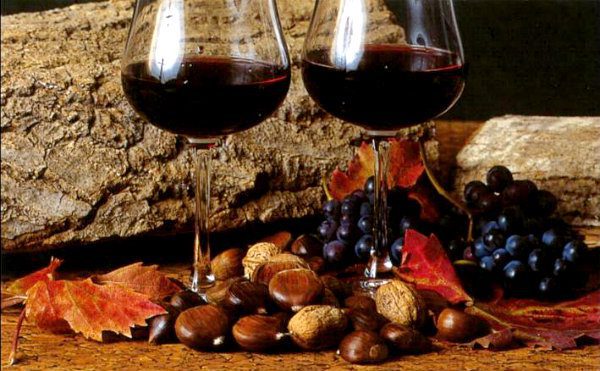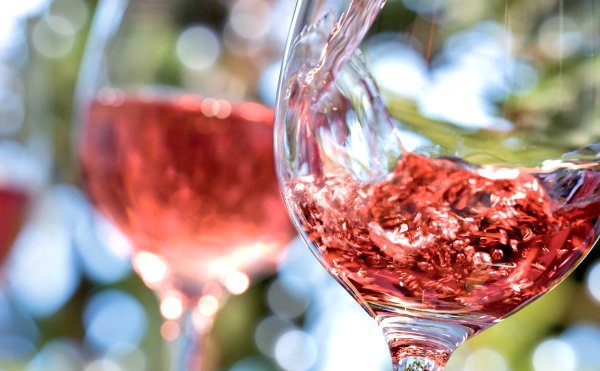Vinification in Red
- CRUSHING / DESTEMMING = must always be soft to avoid excessive tannin extraction, which is why destemming is increasingly carried out at the same time or before crushing. The removal of the stems reduces the amount of herbaceous aromas and ethyl alcohol absorbed during fermentation.
- MUST WITH MARC = maceration is the contact of the skins with the liquid must, which is gradually transformed into wine. The maceration time is a key factor in allowing the colour pigments and other substances in the skins to dissolve.
- MUST TREATMENTS AND ADDITION OF SELECTED YEASTS = After treatment and possible corrections, the must is placed in stainless steel fermenters. After addition of the yeasts, the must starts fermenting in contact with the marc (skins and grape seeds).
- FERMENTATION WITH MACERATION = By managing the maceration time, one can intervene differently on the extraction, safeguarding the elegance of the final product. In the first few days of contact, mainly anthocyanins are extracted, which give very intense colours with pronounced shades of ruby red, violet or dark blue within a few days. In the following days part of the pigments are reabsorbed by the skins and the colour weakens a little to the advantage of a better polyphenol extraction (influenced by: time of contact of the must with the skins, temperature, pumping over, punching down, presence of sulphur dioxide and enzymes) total and thus a greater structure and taste of the wine. The fermentation of some red wines may end in barriques, where the wine being made is enriched with the aromatic components of the wood. Many red wines are produced with a maceration of 10-15 days, for lighter wines to be consumed young it is reduced to 4-5 days, while only a few musts are left to macerate for up to 4 weeks (Langhe, Barolo). The high fermentation temperature is another factor that increases the dissolution of substances in the skins but does not always maintain the quality of the wine. The compromise is reached around 25 °C for wines to be drunk young in which it is important to preserve the fruity aromas, 30 °C for wines to be aged in order not to damage the yeasts and not to alter the organoleptic characteristics of the wine. During fermentation, the grape marc forms a compact layer on the surface called a CAPPEL, which prevents good contact with the liquid part. To remedy this drawback and favour extraction, the must is stirred with the fulling or pumping over. At the middle or end of maceration, all the liquid part of the must is removed from the tank, leaving only the solid part inside. Then the liquid is reinserted from above or below and completely breaks the cap formed by the skins. This achieves the twofold objective of oxygenating the must very well and stirring up any substances that may have stratified, thereby aiding the fermentation and extraction processes. As the must continues to ferment, the yeasts transform the sugars into ethyl alcohol and carbon dioxide, form secondary substances, the colour becomes more intense and many components are extracted and pass from the skins to the liquid part. Since the carbon dioxide causes the must to bubble, this step is called TUMULTUROUS FERMENTATION.
- UNWINDING = removal of fermentation skins and lees, dead yeast cells, coagulated substances, salts and small solid particles.
- TORCHING = delicate process for drying the grape marc, still soaked in must-wine with horizontal membrane presses or continuous presses. The process must be gentle at the expense of yield to avoid an astringent and acidic product.
- POSSIBLE MALOLACTIC FERMENTATION
- MATURATION IN STEEL AND/OR CASK = serves to perfect the balance of the wine
- TRAVERS
- CORRECTIONS/STABILISATION
- BOTTLING
- REFINING
But why is it so important to cool the wort?
The optimum temperature at which the yeasts carry out fermentation is between 15 and 30 °C, producing good quality secondary compounds. If the temperature is lower, their action is inhibited, while if it is too high, fermentation becomes uncontrollable and the elegance of the final product is penalised.
Alcoholic fermentation produces energy that is released in the form of heat, which increases the temperature to values that would damage the aromas and quality of the wine. Moreover, above 37 °C, the action of the yeasts is blocked, which is why it is essential to refrigerate the must, especially in warmer areas. Ethyl alcohol is no friend of the yeasts because above 15-16 % it inhibits their fermentation activity, as can happen in wines made from musts that are very rich in sugar, from grapes that have been dried or attacked by noble rot. There are different cooling systems:
COOLANT
Steel fermenters are equipped with a double wall inside which a cooling solution circulates, keeping the surface of the walls cold, while mechanical agitation breaks the cap of the marc and helps to lower the temperature of the must.
SUBMERGED HAT
Fermentation is carried out in a SUMMERED CAP with a perforated diagram that keeps the cap of marc below the level of the liquid so as to favour its contact with the wine that is being made, encouraging the extraction of polyphenols and other substances.
REMOVAL
Part of the product is tapped from the bottom of the fermenter through an external pipe, recirculated and sprayed onto the solid layer. This promotes the exchange of the liquid in contact with the skins and homogenises and oxygenates the mass and redistributes the yeast.

Carbonic Maceration
Carbonic maceration is applied before the actual vinification. The whole bunches are placed in tanks saturated with CO2, where they are left for periods of between 5-10 days at around 30 °C to encourage the production of fragrant substances and glycerine, the migration of pigments and other components from the skin to the pulp, and the breakdown of part of the malic acid. To avoid dangerous oxidation, sulphur dioxide is added. These conditions favour a partial intracellular fermentation, without the intervention of yeasts, which will only be added later. Alcoholic fermentation will then be fast, from 2 to 4 days, and the wines will have intense and very lively colours, floral, fruity and vinous aromas, they will be fresh but already balanced, with delicate tannins and unsuitable for ageing. This is why 'novelli' wines are the only ones to be put on the market so early, starting on 6 November of the same year as the harvest, which must be stated on the label.
The Beaujolais Nouveau is the French new wine named after the production area, Beaujolais. The French invented this type of wine in 1934 during an experiment that involved storing bunches of grapes in carbon dioxide. After a couple of months, they realised that the grapes had become gassy and fizzy, with a very distinctive flavour. Since these grapes were no longer suitable for marketing, they decided to vinify them and obtained a 'different' but very interesting wine.

Rosé wines
There are various systems for producing rosé wines, although the most widely used is the one involving a short maceration of the marc in the liquid part of the must. An alternative is to use black grapes that are not very pigmented and poor in tannins, or one can blend black and white grapes. You cannot mix a red wine with a white wine! Despite their colour and regardless of the system used, rosé wines have organoleptic characteristics closer to those of white wines. They are destined to be appreciated in their youth, thanks to their beautiful colour tones, delicate and fragrant aromas and fresh flavours.
I vin gris are wines with a rather pale pink colour. Grey wines are produced using the same oenological procedures as white wines, the only difference being the use of grapes with a very low colouring capacity, such as Cinsaut Rose, Cinsaut Gris and Cinsaut.
I blush wines have become famous in the United States largely due to the White Zinfandel phenomenon, produced from the notoriously red Zinfandel grape using normal winemaking practices for white wines. They have a sweetish taste and a slight effervescence. In California some wineries produce blush wines dry and barrel-aged and which are typically known as vin gris.
